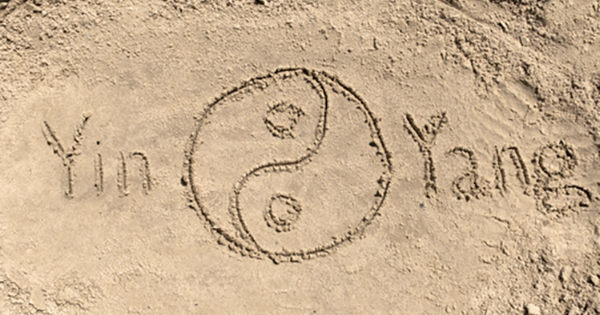Sayings that reflect the principles of yin and yang include “don’t resist and don’t lose connection” (bu diu bu ding 不丢不顶) and “not butting against or collapsing; being neither flat/losing nor resisting” (ding bian dui kang 顶匾丢抗). These errors are compounded by double weighting. Maintaining the energy cycle produced by a rotating ball, at the point(s) of contact with an opponent, helps reduce these errors by clearly differentiating yin from yang and having simultaneous yin and yang energy on either side of the contact point.
If a cycle of yin and yang is created, there is the potential for continuous and smooth power generation. Like turning a steering wheel, with one hand pulling the wheel (yin) while the other hand pushes the wheel (yang), both hands (energies) can contribute to the rotation, although typically one will be more prominent than the other. Rather than just having the pull (or just the push) you can have the energy of the pull and push summed together. This conforms to the saying that hard and soft mutually assist each other (剛柔相濟 gang rou xiang ji).
Creating a cycle also helps prevent coming to a stopping point where an end of the rotation, or extension/retraction, is reached, resulting in a brief pause before changing direction. Linear movement creates stops, whereas moving cyclically in arcs and spirals can be used to produce continuous changes.
A properly inflated ball also inherently has six-direction force or energy, which means forward/backward, up/down and left/right. This could also be stated as being the XYZ coordinates, i.e., three dimensional. The air that fills the ball provides a three dimensional structure to the ball, and the ball can respond to energy impacting it from any direction.
When the ball is stationary, all directions maintain their potential. When touched and the ball begins to move, at least one direction will become emphasized, but all the other directions maintain their potential. This is difficult for practitioners to emulate, but it is an important principle. In order to freely and smoothly change, one should maintain the six directions (all directions) potential even when one or more direction is emphasized.
If the six directions energy is maintained constantly, then it is easy to almost instantly switch from yin being emphasized to yang being emphasized. This is because the potential for forward/backward, up/down and left/right are all already present, all that is needed is to switch which is emphasized. Again using the steering wheel analogy, it is easy and can be immediate to switch emphasis from one hand to the other. It is like attack and defense are simply two sides of the same coin, or for our ball analogy, two sides of the ball.
Although most practitioners do not have experience with Taiji gun (棍 staff), I will use it as an example of the principles discussed in this article since interactive staff illustrates these principles, and others, quite clearly and should be relatively easy to visualize, even for those who do not practice staff.
In most Chinese two-person staff forms, observers will see the staffs bouncing off of each other. This is due to the defender being double weighted, using yang/yang (yang on both sides of the contact point with the opponent’s staff), i.e. using force to oppose force. But in Taiji staff we want to develop “stickiness” (nian 黏) rather than allowing the staffs to bounce apart, even when done at full speed and power.
Since staffs are made of wood (typically resilient woods like rattan or white wax wood 白蜡木 bailamu, a type of Chinese Elm), they naturally tend to bounce off of each other when struck together. But in Taiji staff, we want to control the opponent’s staff when contact is made, rather than letting the opponent escape by bouncing off. This stickiness allows control similar to what we practice in weaponless push-hands (tui shou 推手) training.
This stickiness of Taiji staff involves several things. One is that the person holding the staff should have softness (without collapsing) that provides a degree of shock absorption from the blow.

Leave a Reply